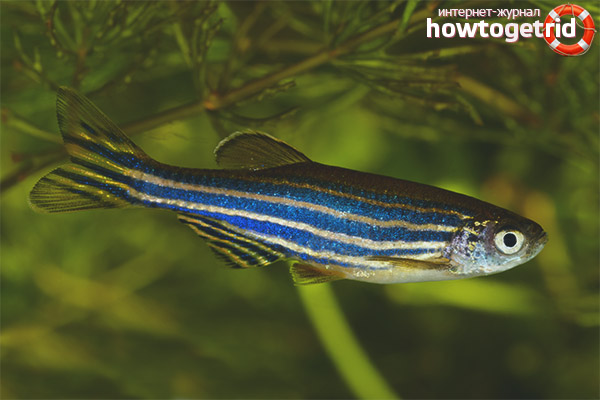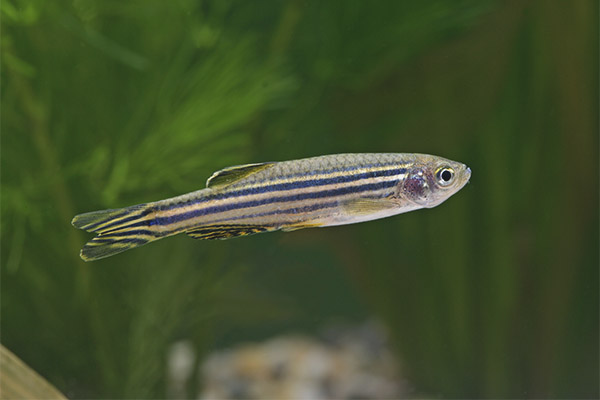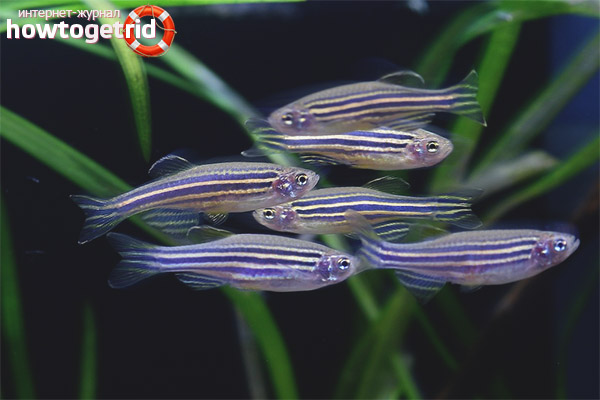The content of the article
Aquarium fish danio rerio is very popular among amateur hobbyists. Previously, its Latin name sounded like Brachydanio rerio. Today it is called Danio rerio. This fish in length usually grows up to 6 cm. The popularity of the species is due to its attractive appearance. In addition, danios live in small flocks, showing activity and playfulness. It differs from other types of danios by the presence of characteristic blue stripes, which are located practically along the whole body. This species is one of the first fish that were used in aquariums.
They began to breed as long as macropods. Although during this time many other interesting and beautiful views were offered to aquarists, the zebrafish has not lost its popularity. In addition, this fish is inexpensive and easy to clean.
Danio rerio unpretentious to the conditions. You can start them even the most inexperienced aquarium lovers. With breeding usually special problems do not arise. Fry also grow quickly. This species refers to schooling fishes. In one aquarium should be from 5 individuals. But it is better if there will be more of them. Neighboring them can any species. The main thing is that they are small in size and do not show aggression.
Resistance to external conditions is a great advantage of the species. For them, do not even need to heat the water. Fish will feel fine, even at a water temperature of 18 degrees. But they still need some care. Flocks can swim for a long time near the filter. This is due to the fact that they are very fond of the flow.
Habitat in nature
To date, danios have different colors. They differ in the form of fins. The most popular varieties are voile, red, pink.The big popularity began to get the fish, painted by artificial means. These genetically modified individuals can be pink, orange, blue. This innovation aroused great interest. Scientists are arguing about whether such interference in genetics will bring harm, but so far no negative phenomena have been noted.
Representatives of the species live in ponds, canals, rivers. Depending on the time of year, they may change place. In the rainy season there are many of them in the flooded fields of rice, in the puddles that have arisen after heavy rainfall. Spawning takes place here. And when the rainy season comes to an end, the fish return to larger reservoirs. Their food is zooplankton, seeds and some insects.
Appearance
Representatives of this species have an elegant oblong body shape. On the lips of the fish there are two pairs of whiskers, a pair on each. In the aquarium, this fish will not grow more than 6 cm. Although in nature they are larger. In the wild, they can live no longer than a year. But in the aquarium such a fish will live about 3-4 years. The body of the fish is pale yellow. On it are blue stripes.
Content issues
There are practically no problems in keeping the fish of this species. First, they get along well with their peaceful neighbors. Secondly, they will eat almost any food. For them, you do not need to create special conditions and heat the water.
How to feed

In nature, food for them are insects, seeds and larvae. In the aquarium, they can eat any food. Favorite delicacy - Artemia and the Tubber. Danio rerio love to collect food from the surface of the water.
Content
As already mentioned, the view is unpretentious. The volume of the aquarium may be quite small. Even in a five-liter aquarium can live a flock of 5 individuals. Danio love to swim in the upper layer, live in flocks. The aquarium should always be covered so that they do not jump out, frightened by something. The males of this species love to play. Watching them is fun. It is recommended to plant some plants in the aquarium, but at the same time leave plenty of space for the flock to swim freely. Lighting should be bright.
It does not matter what water temperature will be maintained. They can vary from 16 to 30 degrees. The fishes will feel great. But for breeding the ideal temperature would be 25 degrees.It is desirable to maintain the pH in the range of 6.6-7.5.
Compatibility
The view is perfect for a general aquarium. It gets along well with most species. It is advisable to contain flocks of 5 or more individuals. In nature, they live in groups, so they will feel uncomfortable one by one. Neighbors can be any small peaceful species.
Sex differences
It is possible to determine which individual the sex belongs to by the size and structure of the body. Males are smaller and sleeker. Females have a pronounced belly, even when there is no calf in it. But with caviar, he stands out even more.
Breeding
Difficulties with reproduction of this species does not arise. But danios rerio belong to molting species, therefore breeding requires special training.
7 days before the proposed spawning, females and males are selected, placing them in different aquariums. The female is determined by the large abdomen and less bright bands. It is important that the fish eat well during this period. The ideal feed will be the choke.
To equip the breeding ground, you should prepare a ten-liter aquarium. If not, then you can do with a can of 3 liters.At the bottom it is recommended to lay a glossy shade or fontinalis. Some aquarists argue that you can put elodeyu. They need to pin down the stones so that the plants do not emerge. It is desirable to lay the bottom of the net. The mesh cells must be of such size that the eggs pass there, but the parents themselves could not reach them.
Water must be defended for about 2 days. The ideal water temperature suitable for spawning is 25 degrees plus or minus one degree. Pour it need a five-centimeter layer.
Before spawning, a female and 2-3 males are placed in the spawn. To understand that it is ready for reproduction, it is necessary to observe the abdomen. If it has become particularly thick in the anal fin region, then the female is ready. Spawning need to put on the window to provide a fairly good illumination. As dawn begins, the zebrafish begins its breeding process. The number of eggs laid by the female of this species may vary in the range of 50-400 pieces.
If the roe has not been postponed for the first day, the individuals are kept in the spawner for another 24 hours. They need to feed the crank. If nothing happens on the next day, then the males settle for 4 days, after which the attempts are repeated.
When breeding fish of this species, it is important to know their peculiarity.After spawning, the female should be placed in spawning again after 7-10 days. Otherwise, they may no longer bear offspring.
When the eggs are laid, the adults will settle. 50% of the water in the spawn is replaced with fresh. It is important that water has the same properties and temperature.
After a few days, the larvae begin to hatch, which can hang on the vessel walls for 2-4 days. Outwardly, they look like strings with small heads. In a few days the fry will swim by themselves. They can immediately begin to feed. For this fit food such as ciliates and rotifers. If for some reason such feed is not found, then the food for them may be the yolk of a boiled egg, which must be diluted with water. But it needs to be given a little. If the yolk remains, the water will quickly deteriorate. In addition, on this feed fry will grow somewhat worse.
The more the fry become in size, the larger their food should be. Slightly older can begin to give Cyclops and Daphnia. When they increase in size even more, they need to be transplanted into a large container.
In the end, we can say that danio rerio will be an excellent option for beginners.Having these beautiful unpretentious small fishes in the aquarium, it is possible to gain experience before getting more difficult in leaving. Despite its simplicity, zebrafish are not inferior to many others in external features. Watching them is very interesting.
Video: aquarium fish danio rerio












To send